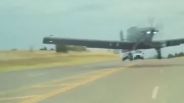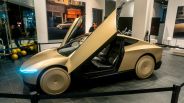Articles by Andrea Alfano
Science Images Of The Week: Origami Zipper-Tube Tower, A Gold Sponge And More
Scientists folded papers into complex origami towers and grew blobs of lung tissue in dishes with beautiful results that they shared with the world this week. Plus, a nanopourous gold sponge and brightly-colored avian survivor.
Where Homo Naledi Fits Into The Human Family Tree And Why It’s Important
The scientific community is abuzz with the news of the discovery of not one, but fifteen skeletons of an ancient human species that has never been described before. Here’s what scientists know -- and just as importantly, don’t know -- so far about where the species fits into our extended human family.
The First Ever Space Whiskey Experiment Reveals 'Groundbreaking' Flavors
Three years ago, whiskey went to space for the first time. Now, experts at the distillery that sent the samples have described the 'groundbreaking' flavor profile of the space whiskey.
Engineers Use An Origami Technique To Design Strong And Versatile New Structures
An origami technique called Miura-ori folding inspired researchers to create a design that allows paper and other materials to support much more weight than they would have been able to otherwise. They call the design 'zippered tubes.'
Why Your Tan Disappears By Winter
Tans are sun protection for your skin, yet they don’t stick around all year. Why does skin change back?
What Happens When A Virus Is So Big That Other Viruses Infect It
A little over a decade ago, scientists discovered giant viruses so large that they were mistaken for bacteria in the past. They can even get infected by other viruses.
This Week In Space: A Virtual Ride Aboard New Horizons And A Successful Trip To The ISS
Reflections on New Horizons' journey to Pluto, plans to build a real-life tractor beam, and more this week in space. Plus, the discovery of a quasar powered by not one, but two black holes.
Chimp Demonstrates A New Tool-Using Behavior By Destroying A Drone With A Stick
Chimps: 1. Nature documentarians: 0. Scientists: This is very interesting. For nature documentarians trying to get shots of animals in inconvenient places, camera-carrying drones are basically the best thing since sliced bread.
Science Images Of The Week: Double Black Hole, DNA Nanobots And More
Cutting-edge tiny technology and giant ancient sea monsters were among this week's most amazing science images. Plus, a male giving birth and a quasar powered by a pair of black holes.
Slow-Melting Ice Cream, Brought To You By Science
Messy ice cream cones may soon be a problem of the past, thanks to a special type of protein. Scientists are working on turning this protein into a protective coating for ice cream that prevents drips.
A Robotic Exoskeleton Allowed This Paralyzed Man To Walk Again
Blind and paralyzed from the waist down, Mark Pollock is fighting to regain some of the physical abilities most people take for granted. By non-invasively stimulating his spine and training his legs using a robotic exoskeleton, Pollock has managed to win back some movement in his legs — and in doing so, became the first paralyzed person to regain this level of control.
Amazing NASA Animation Shows New Horizons’ View Of The Pluto System
It took 10 years for New Horizons to reach Pluto. Now, you can relive the climax of this epic journey in under 30 seconds.
A Simple Treatment Allows Coffee Grounds To Capture Climate Change-Causing Methane
Scientists found that bathing coffee grounds in a simple solution commonly found in home oven cleaners and then heating them converts them into methane sponges. As a result, this human fuel byproduct could help provide a more sustainable form of fuel for our vehicles.
Chasing Life On The Red Planet: An Interview With Mars One Candidate Laurel Kaye
Mars One is a private space compay that aims to send six teams of four people to Mars – permanently – beginning in 2027. Tech Times spoke with Laurel Kaye, one of the final 100 candidates for the mission, about her experience thus far, her hopes for life on Mars and her concerns about the idea of leaving the only home she's ever known forever.
Beating Heart-In-A-Box Technology Is Salvaging Organs For Transplant
Disembodied beating hearts are the stuff of horror stories, but a new medical device is turning this creepy concept into a lifesaving strategy. This heart-in-a-box technology has already saved more than a dozen lives.
Podmasters: Buddhist Geeks' Vincent Horn On Meditation In The Modern World
Integrating meditation and technology is a tricky task, but the Buddhist Geeks podcast attempts to do just that. Tech Times spoke with Vincent Horn, founder of the podcast and self-described mind hacker and Buddhist geek.
Oliver Sacks’ 'Awakenings' That Didn’t Make It Into The Movie
Neurologist and writer Oliver Sacks is best known for his book ‘Awakenings,’ which was made into a movie starring Robin Williams in 1990. The book and film focus on lifting patients out of a disease-induced stupor, but Sacks spent his entire career awakening the public as much as his patients.
How The Moon Affects Tides
Can you explain why the tide goes in and out? Gravity is key. The tides were once one of the great mysteries of our planet — and to some, they are apparently as perplexing as ever.
A Double Black Hole Powers Our Galaxy’s Closest Quasar
Quasars are the brightest objects in the universe, and they are fueled by the darkness of black holes. Scientists recently found the first example of a quasar powered by a pair of black holes instead of a single supermassive black hole.
Chemical Traces In Fossilized Dinosaur Feathers Shed Light On Their True Color
By analyzing trace chemicals left in fossilized dinosaur feathers, researchers have finally settled the debate about whether color-conferring structures called pigments are preserved. Chemical signatures confirm that the structures that gave dinosaur feathers their color are in fact present in some fossils.
Heart Patches Made From Tissue-Velcro
Velcro-like layers of tissue could one day be used to patch up damaged heart muscle. Interlocking layers of heart tissue make it possible to create tissue patches that contract in response to electrical stimulation.
This Week In Space: Of Black Holes And Butterflies
Stephen Hawking may have solved a long-standing problem in astrophysics with math, but NASA is working on pre-empting problems by crashing expensive pieces of equipment. Plus, fire fountains on the moon and a cosmic butterfly.
Biohackers Are Having Fun Rewriting Genes With CRISPR
CRISPR is a new tool that is making genetic engineering easier than ever before. Even amateur biologists are taking part in the CRISPR revolution.
Science Images Of The Week: Cryogel Cancer Vaccine, Missing Link Lizard, And More
Discoveries abounded this week, with new species of nautilus, lizard and crustacean. Plus, an aerial shot of the Atacama Desert, a cryogel cancer vaccine, and a rare mineral.
Microscopic 3D-Printed Fish Steered By Magnets Could Aid Drug Delivery
Fish is not a metaphor here. These microscopic, 3D-printed robots are actually designed to look like fish.
Injecting Tumor Cell-Packed Cryogels To Turn The Immune System Against Cancer
Scientists at Harvard University have devised a new approach to creating a cancer vaccine. Their work suggests that packing cancer cells into a spongy material called a cryogel and injecting it into the body could be an effective way to train immune systems to target cancer.
A Drug That Millions Take For Diabetes May Fight The Fundamental Causes Of Aging
Metformin, a drug commonly used to treat diabetes, is slated to undergo a clinical trial as a drug that targets fundamental biological processes involved in aging. The study is not aimed at achieving immortality, but it is about aging less like a flower and more like a fine wine.
How Big Is The Heart Of A Blue Whale?
Thiiiiiiiiiiiiiiiiiiiiiiiiiiiiiiiiiiiiiiiiiiiiiiiiiiiiiiiiiiiiiiiiiiiiiiiiiiiiiiiiiiis big. Blue whales have the biggest hearts in the world, and a scientist at the Royal Ontario Museum is proud to show off the prized specimen in their heart collection.
Ants Treat Their Own Fungal Infections With Natural Medicine
An anti-fungal found in nature is typically toxic to ants, but when they become infected with a deadly fungus, the risk is worth taking. Scientists found that infected ants seem to self-medicate by ingesting substances that might harm the invading fungus more than themselves.
How Extremely Tiny Diamonds Could Be Used To Deliver Drugs
Diamonds so tiny that you could fit thousands of them in a grain of sand could one day be used to save lives. Scientists are developing ways to use nanodiamonds to improve drug delivery for more personally-tailored treatments.




